A daysailer was once simple and small, an entry-level passport to the sport. In the new millennium, however, that has changed. Simplicity may still be a watchword, but the boats have grown into what could be called trophy boats. Hinckley Co.s latest daysail boat is 42 feet long. Morris Yachts is marketing a boat that stretches 53 feet as a daysailer. Ted Fontaine at Friendship Yachts already has built one that size. And these are only a few of the daysail boats with minimal accommodations, big cockpits, and over-size price tags that are filling up the fleet. In all, more than a dozen elegant daysailers have made it to market. This article compares an even dozen: the Alerion Express 28, 33, and 38 (Pearson Composites); e33 (e Sailing Yachts, Robbie Doyle and Jeremy Wurmfeld); the B-38 (Luca Brenta); Bruckmann 42 (Bruckmann Yachts); Crosscurrent 33 (Maxi Dolphin); the Friendship 40 (Ted Fontaine); Harbor 25 (W.D. Schock); Hinckley 42 (Hinckley Yachts), J-100 and J-124 (JBoats), Morris 36 (Morris Yachts), Sabre Spirit (Sabre Yachts), and the wallynano (Wally Yachts).
****
By Ralph Naranjo
Lacking the time and opportunity to pursue racing and cruising the way that we used to, many of us have taken to daysailing. A daysailer was once simple and small, an entry-level passport to the sport. In the new millennium, however, that has changed. Simplicity may still be a watchword, but the boats have grown. Hinckley Co.s latest “DS” is 42 feet long. Morris Yachts is marketing a boat that stretches 53 feet as a daysailer. Ted Fontaine at Friendship already has built one that size. And these are only a few of the boats with minimal accommodations, big cockpits, and over-size pricetags filling up the fleet.
In all, more than a dozen “elegant daysailers” have made it to market. They have been well-received. Some say they represent the only real growth in new boat sales. Boosters claim they “address the kind of sailing that we actually do.” Cynics call them “a triumph of smoke and mirrors, branding, and snob appeal.”
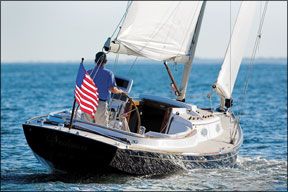
Photo courtesy of Alerion Express
The dollars involved-up to $800,000 “base price”-made us wonder what they have to do with the average Practical Sailor reader. We tried to ignore the buzz the daysailer resurgence created at boat shows and in the glossy mags. Ultimately, it all boils down to this: These boats, like any other, get their “character” from their “characteristics.” Style, performance, control, comfort, and quality are key ingredients whether youre talking about a Sunfish or a Brenta 38. We focus here on todays “elegant daysailers” mostly to find out whats happening in this sphere and if we should pay attention.
The beginnings
Todays day boats harken back at least as far as 1912. Thats when Nathanael Herreshoff designed the 26-foot Alerion for his personal use. Like the boats of today, it provided nothing but the basics in terms of accommodation. Likewise, it was comfortable to sit in, sprightly under sail, and very pretty to behold.
The original is enshrined in the Mystic (Conn.) Seaport museum, but Garry Hoyt, always in search of a brighter idea, joined forces with designer Carl Schumacher around 1993 to produce a modern version. The Alerion Express 28 is true to the timeless look of the model, but made of modern materials and given a modern (though hardly unknown to Capt. Nat) fin keel and spade rudder. Advertised as “the prettiest girl at the dance,” over 400 hulls have been sold to date.
After developing more Alerions (20, 33, and 38), Hoyt left builder Pearson Composites, and a fleet of competitors appeared on the horizon.
President Jeff Johnstone of J-Boats recalls the 1992 U.S. Sailboat Show in Annapolis, Md., when a J-35 and the new J-105 were displayed side by side. Visitors could be heard wondering out loud, “Are the cruising amenities on the 35 worth the $50,000 price difference?”
“Today, especially if you live where you sail, people are realizing that they don’t need all the cruising stuff,” says Johnstone. “After all, if youve got a galley, somebodys got to cook.” We look at two J-Boats (J-100 and J-124) in the performance daysailer race.
The Hinckley Co. of Southwest Harbor, Maine, began building lobster boats in 1928. With sailing exemplars like the Bermuda 40 and Southwester 42, it achieved prominence in the yacht-building world. When it returned to the lobsterboat archetype with its Picnic boat in the mid 1990s, the full-circle was spectacular.
“People told us we were crazy building half-million-dollar 36-footers that slept just two,” says Sales Director John Correa. But style, luxury, and innovation (combining water-jet propulsion with joy-stick control) made the Picnic boat a legendary success (over 300 sold). Employing the same designer (Bruce King) and a somewhat similar approach, Hinckley recently introduced its DS 42, marketing it as a sailing Picnic boat.
The Friendship 40 was another boat inspired by the Picnic boat phenomena. “When I left Hinckley to start my own business,” explains designer Fontaine, “that Picnic-boat-with-sails idea, a boat that didnt depend on a commitment to racing or cruising, made sense. Since then, Ive taken my own tack, refined my ideas, found a builder, and sold more than a dozen. The Friendship sloop was the original lobsterboat. My Friendship 40 builds on that inspiration. But she has full headroom.”
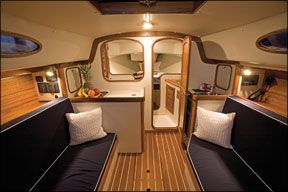
courtesy of Alerion Express
Most American builders have, like Hoyt, chosen to base daysailers on traditional models. From Europe, however, come entries that are decidedly futuristic. Milanese designer Luca Brenta is best known for offshore megayachts (Ghost, his various Wallys, and Swans custom Brenta 76), but hes also pursued another theme since he opened his office in 1986: His “B project” is a “quest to maximize pure pleasure under sail for all those aboard.” Teak decks, sofa seating, skin-tight sheeting angles, dual wheels, hydraulic sail controls, and more are part of his B-38. So, too, is styling that makes it a Ferrari among Model-Ts.
Also from Italy comes Maxi Dolphins Crosscurrent 33 and Andre Hoeks 36-foot Wallynano. To date, the innate conservatism of the American market has coupled with the declining dollar to keep these imports from having a major impact here.
Morris Yachts was doing well building quality cruisers when a wooden 1930s vintage 34-footer named Poppy was consigned to the yard for restoration. Designed by Sparkman & Stephens, the boat was resurrected to the point where it became the “boat of the fleet” at S&Ss 75th anniversary, a reunion that included such icons as Bolero, Dorade, Stormy Weather, and other classics. When Morris Yachts founder Tom Morris (who passed away in December) came upon an updated version of Poppy in the S&S files, he and his son, Cuyler, president of Morris Yachts, set out building traditional weekenders with sitting headroom, belowdecks sheeting, and no lifelines. They sell for “about $350,000” and are closing in on number 30.
The Harbor 25 from W.D. Schock, the e33 from sailmaker Robbie Doyle and Jeremy Wurmfeld, the Bruckmann 42 from Doug Zurn and Mark Bruckmann, and Jim Taylors Sabre Spirit round out our sample field. The last three show clearly that builders and designers of various backgrounds are being drawn into this daysailer movement.
Style
Boats conceived without regard to handicap rules can achieve better speed. Similarly, daysailers offer a freedom from headroom, interior volume, and payload constraints. That enables their creators to concentrate on making them look good. Style becomes paramount. Lots of “pretty girls” have arrived at the dance.
Taste is subjective; beauty is in the beholders eye. For this survey of aesthetics, weve leaned upon the words of L. Francis Herreshoff, as written in his classic “The Commonsense of Yacht Design”: “Beauty is an attribute which delights the eye and the mind; delicacy of outline, harmony of proportion. The sole interest held by the eye in a straight line is in bending it. A curve to be interesting must be continually changing. Curves of a fixed radius are predictable. The reverse curve is vastly more interesting.”
Guided by these principles and a lack of commonsense, we rated and compared the looks of these beautiful boats. Highest on our list came the Alerion Express 28. Perhaps its our romantic preference for hull lines “sculpted” via carved half-model (as were those of Capt. Nat), but the limits, proportions, and resonances evident in the Alerion Express 28 seem just right. Its smaller and larger near-sisters seem less exquisite. Prejudice and snobbism could be causing us to prefer Schumachers “original” over the updates, but to us, theres a difference.
We gave equally high marks to the B-38. Totally different than the AE 28, it appealed through unity, integrity, and boldness. Says Eric Hall of Hall Spars: “I see lots of boats, and she is one of the few that made me fall in love. “
The Crosscurrent is also sexy, but its relatively low-aspect rig makes it seem squatty. The tumblehome transom and counter stern on the Friendship 40 not only echo the Friendship sloop but appeal on their own. The boats tall rig and low freeboard are a bit upsetting, but her ports, coamings, and house profile are masterful.
The Morris 36 is the queen of moderate. Stem and stern angle are restrained, its sheer has spring without slouch, and its house stops short of cluttering the skyline.
Pretty as they are, the next boats fall one tier, in our view: The bigger Morrises are endier than the 36, just a touch ungainly. Though we liked the jaunty, semi-hollow bow on the Bruckmann 42, the after part of the boat seemed overlong and a bit too low.
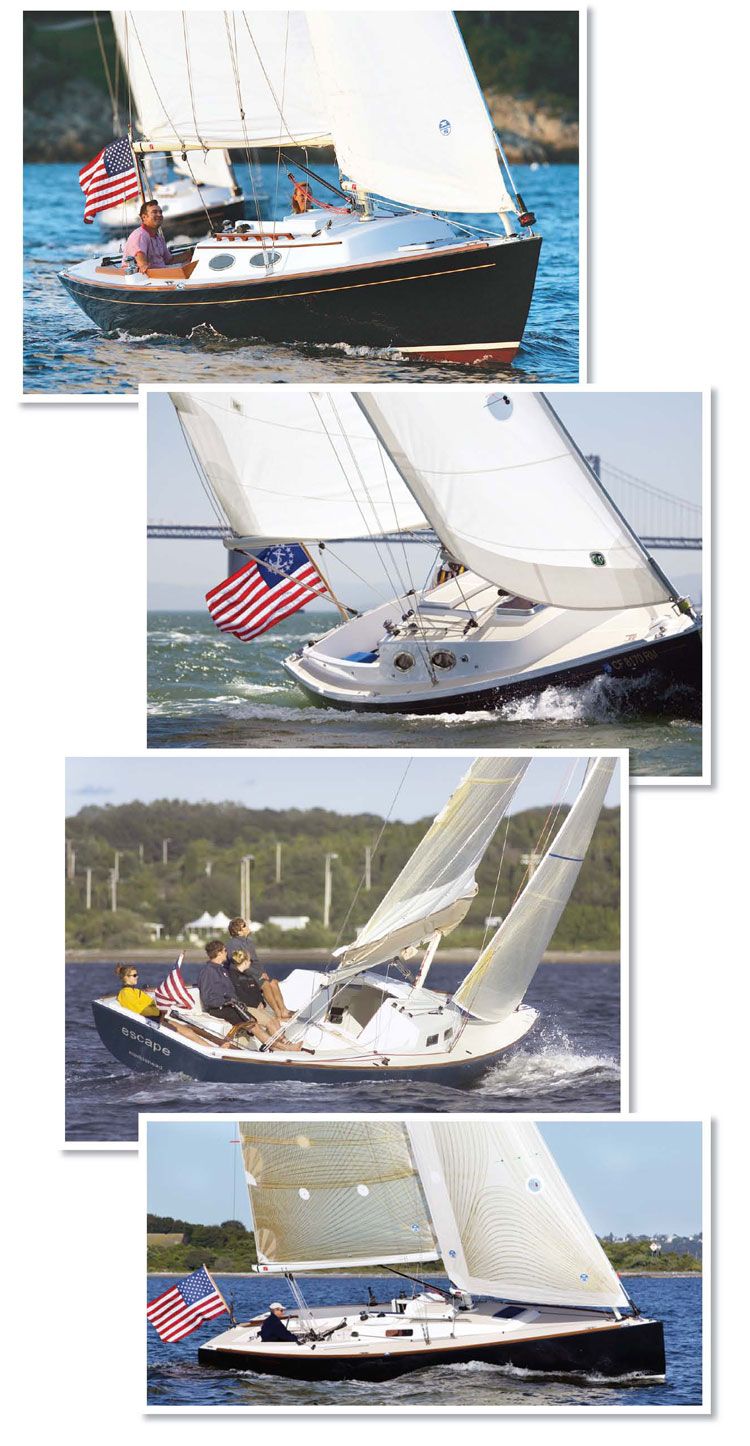 From top, Alerion Express 28, Harbor 25, e33, and J-120 offer a look at what emerges when designers are allowed to focus on fun. (Photos courtesy of manufacturers)
From top, Alerion Express 28, Harbor 25, e33, and J-120 offer a look at what emerges when designers are allowed to focus on fun. (Photos courtesy of manufacturers)Robbie Doyle, founder and president of Doyle Sailmakers, calls his e33 “an Etchells on steroids,” but theres nothing ugly or bloated about the boat. If anything, its looks are a bit understated.
Crisp and balanced, the Sabre Spirit surprises by providing four bunks and full headroom in a boat that doesn’t stand out from the others.
The J-100 and J-124 have a distinct resemblance to the rest of the J-family. Its a sharp look, a look to be proud of, but not that expressive or unique.
Last on our style sheet come the Hinckley, the Harbor 25, and the Wally. Built by W.D. Schock, the Harbor is pleasant, unassuming, almost bland. It comes at the bottom because it doesn’t try to impress visually. The Hinckley and the Wallynano, on the other hand, try too hard. Faux-painting a carbon-fiber spar to look like spruce (as Hinckley does) recalls the wood-panel station wagons of the 70s. The luxuriant curves that distinguish Kings Picnic boats and mega-yachts look, to us, silly and extravagant on the daysailer. Given its minimal waterline and over-done overhangs, we find the Hinckley DS42 awkward rather than appealing.
Among the Europeans, vision and design intensity shine through in the B-38. The Wallynano, on the other hand, seems mixed up. Its “retro” reference to an outdated archetype combined with a cluster of clashing stylistic elements and conflicting purposes leaves us bewildered rather than bewitched.
Performance
Sailing performance isn’t as subjective as style, but neither is it a function of simple numbers. Though some look a bit like sportboats, delivering maximum speed isn’t what these daysailers are about. Rather, they all promise to be “lively and rewarding” without resorting to extra sails or crew. By sailing them, analyzing their designs, and gathering available intelligence, we tried to determine which candidates keep that promise best.
The B-38 looks like a rocket ship. Its sail area/displacement ratio of 31.4 is the highest in sight. With a beam of just 8 feet and a high ballast-displacement ratio, this formula for sailing-fast, flat, and under control -makes it the “high performance” option and puts it atop our performance rankings.
The Crosscurrent 33 relies more on beam and a low center of effort for its stability. Conceived by its builders at Maxi Dolphin as a day racer, it is robust enough to earn Class A (ocean certified) status but, laboring under a Performance Handicap Racing Fleet (PHRF) rating of 40, it proved sluggish, finishing last in its class at Key West Race Week. Gifted now with a PHRF 72, it has proven more competitive.
For the majority of these boats, racing isn’t the objective. Still, competition is the laboratory where performance gets refined. Explaining the genesis of the J-100 and J-124, Johnstone says, “It all begins with an easily driven hull. Going all the way back to the J-24 (over 5,400 sold), that was the key. With a slippery shape, you can afford a moderate sailplan. Working with a rating is, after all, determining how little measured sail area you need. Hull shape, weight placement, deck layout, raceboat design is intense.” Their longer waterlines, planing surfaces, and deep racing background earn the Js a spot behind the B-38, but ahead of the rest in the pecking order.

Photos (from top) by Billy Black
The e33 is Doyles first design. “Ive been campaigning an Etchells 22 for some time. [Hes finished in the money in the last three world championships.] Why can’t I bundle the fun of sailing dinghies in a boat for us “old guys” who don’t want to wake up sore after a regatta?” says Doyle. With S&S graduate Wurmfeld, Doyle developed “a narrow boat with a big bulb and controllable (no winches) units of sail.”
Wed heard the boat had “too much main” for average sailors, but while sailing it, we found that its 2,500-plus-pound deep keel kept it quite forgiving. Dodging through Marbleheads mooring field, it handled much like a dinghy (Practical Sailor, November 2008).
The Sabre Spirit, despite weighing 3,400 pounds more than the e33, is nimble, too. Rather than a big-roach main like the e33, it has a taller, pointier, triangle controlled by a backstay. Says designer Jim Taylor, “We think the average sailor appreciates being able to get the most from the main without being an Olympian. Certainly with the small jibs on these boats, the mains become critical.” Sabre calls the boat a “weekender”-less racy than a dinghy, perhaps, but snappy nonetheless.
Sail area/displacement (horsepower/weight) calculations demand a grain of salt. They derive from figures that can be skewed, and reflect but few of the many factors that determine performance. Still, its significant that the remaining daysailers have similar SA/D ratios. With the exception of the Friendship 40, they are all very much alike.
Fontaine worked for years with sailmaker and designer Ted Hood; the F40 is a wide, whale-bodied, keel-centerboarder with a generous rig and hefty displacement reminiscent of the boats that Hood designed and campaigned. The rest are moderate-to-light displacement hulls with proportionate overhangs, narrow beams, separated rudders, and deep fins with bulbs. That directs the focus to ballast/displacement. The more the boats overall weight is used to produce stability, the better it can carry sail. Thats why the Harbor 25 (0.45) and Bruckmann 42 (0.46) look good. Alerions lesser numbers (0.38 and below) help explain why weve sometimes found them cranky in strong winds (over 18 knots, true).
We can confirm that the M-36 is slippery enough to headreach farther and faster than most modern racers weve sailed. We also have seen it soundly trounced upwind by a modern 35-foot racer-cruiser.
Two boats could not be more different than the Friendship and the Hinckley. So far, they have met in day races four times in all kinds of breeze. At last check, the score was 2-2. Go figure.
Control
The aim here is to make it easier to go sailing. Crew weight used to be needed to balance the rig. With deep bulb keels, thats no longer true.
Getting rid of big headsails is great. Hoyts patented wishboom does a fine job-especially off the wind-on the Alerions, the Js, and the Harbor. The Bruckmann and Sabre Spirit are self-tacking by virtue of a single sheet led from a car on the foredeck track to a point high on the forward side of the mast. Morris uses basically the same geometry, but has the sheet disappear inside the spar and return to the cockpit invisibly. Hinckley, Brenta, Crosscurrent, and Doyle use a pair of sheets to control a non-overlapping jib that lives on a roller furler. The end result: No one fights a big genny, anyone can tack the boat singlehanded, and, unfortunately, line chafe is now out of sight and out of mind.
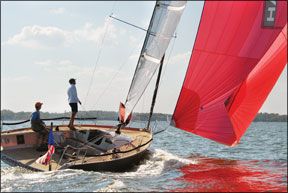
courtesy of Bruckmann Yachts; by Onne van der Wal
Sailing in 6 to 10 knots of breeze, we miss the power of the big sail somewhat, but attention paid to the main pays off in good acceleration even in low-pressure puffs. High-roach mains (e33, Alerion, Brenta, and Crosscurrent) have been proven on multihulls and sailboards to be more efficient than pointy-headed planforms. Having more of their sail power located in the controllable mainsail makes all of these boats easier to sail.
Comfort
A keen eye toward comfort helps explain why todays trophy boats are so big and why they offer so little-a minimum of 4 feet-in shoal draft capability. Ballast displacement ratios count for a lot when it comes to keeping the boat upright.
In addition, the daysailers are drier than the little boats they replace. “I will always prefer the narrow boat in a seaway,” said Olin Stephens. Morris has capitalized on the S&S heritage with excellent seakeeping boats.
Fontaine has sailed the Friendship from Maine to the Caribbean. Doyle took the e33 on last summers Eastern Yacht Club cruise. In a universe where flat-bottomed, shallow-draft auxiliaries are the norm, these boats (with the obvious exception of the Italian imports) can be comfortable at sea.
Because its where sailors spend their time, cockpits have grown and luxuriated. You may bang your shins or be forced to sit below, but in the cockpit, youre king. Only the B-38 offers couches, but no maker here scrimps on cockpit comfort.
Although the usual owner of some of these boats isn’t the kind to paint his own antifouling, we can’t help but grouse about exterior wood flourishes that seem only to elevate the conspicuous consumption quotient.
Quality
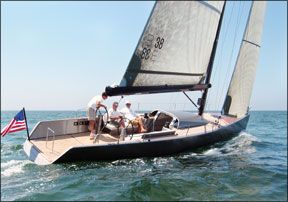
courtesy of Friendship Yachts; courtesy of manufacturers
They may be retro in terms of aesthetics, but the trophy daysailers are up-to-the-instant in terms of boatbuilding.
From scrimp resin-infusion through vacuum-bagging and mixed-laminate composites, the hulls are high-tech. Getting the weight out of the structure and into the keel is the norm. Virtually all the boats have carbon-fiber masts (stiffer, easier to tune, and lighter). Velocity prediction, computer modeling and fairing, even programs to calculate sheet loads have helped engineer “products” very well.
In terms of construction, the
Sabre Spirit stands out in this field as one of the better values.
Conclusions
Our first reaction was a paralytic form of sticker shock. Looking closer did not make the obscenity vanish, but weve adjusted a bit.
In an age of Wall Street bailouts, McMansions, and Manny Ramirez, millions get thrown around pretty easily. A boat you can enjoy, even love, can make the big dollars seem less far-fetched. Many of these trophy boats are lovable. For the most part, theyre gorgeous, well-made, and lots of fun to sail.
Choosing among them, we favor the genuine (like the Herreshoff-inspired Alerion) for looks and the competition-forged (Js and e33) for performance. We can’t help but fantasize about the B-38, identify with the down-to-earth mission of the Sabre Spirit, and hope that the Harbor 25 is extraordinary enough to confirm its spot as the bargain. We hate to dismiss the Bruckmann and the Crosscurrent as “me-too” imitations, but we found little that made them distinctive.
Popular boats like the Morrises and Hinckley daysailers don’t, in our opinion, justify their big tickets. However, owning an “elegant head-turner” is something many sailors are willing to pay for.
Ultimately, these daysailers seem to point toward a simplicity and ruggedness that replaces the “second home” mentality in favor of “the joy of sailing.” That much we can appreciate.




































